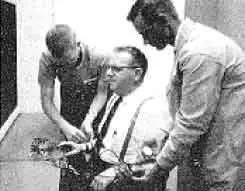The Milgram Shock Experiment - Updated 2017
By Saul McLeod
November 19, 2019 "Information Clearing House" - One of the most famous studies of obedience in psychology was carried out by Stanley Milgram, a psychologist at Yale University. He conducted an experiment focusing on the conflict between obedience to authority and personal conscience.
Milgram (1963) examined justifications for acts of genocide offered by those accused at the World War II, Nuremberg War Criminal trials. Their defense often was based on "obedience" - that they were just following orders from their superiors.
The experiments began in July 1961, a year after the trial of Adolf Eichmann in Jerusalem. Milgram devised the experiment to answer the question:
Could it be that Eichmann and his million accomplices in the Holocaust were just following orders? Could we call them all accomplices?" (Milgram, 1974).
Milgram (1963) wanted to investigate whether Germans were particularly obedient to authority figures as this was a common explanation for the Nazi killings in World War II.
Milgram selected participants for his experiment by newspaper advertising for male participants to take part in a study of learning at Yale University.
The procedure was that the participant was paired with another person and they drew lots to find out who would be the ‘learner’ and who would be the ‘teacher.’ The draw was fixed so that the participant was always the teacher, and the learner was one of Milgram’s confederates (pretending to be a real participant)
The learner (a confederate called Mr. Wallace) was taken into a room and had electrodes attached to his arms, and the teacher and researcher went into a room next door that contained an electric shock generator and a row of switches marked from 15 volts (Slight Shock) to 375 volts (Danger: Severe Shock) to 450 volts (XXX).
Milgram's Experiment
Aim:
Milgram (1963) was interested in researching how far people would go in obeying an instruction if it involved harming another person.
Stanley Milgram was interested in how easily ordinary people could be influenced into committing atrocities, for example, Germans in WWII.
Procedure:
Volunteers were recruited for a controlled experiment investigating “learning” (re: ethics: deception). Participants were 40 males, aged between 20 and 50, whose jobs ranged from unskilled to professional, from the New Haven area. They were paid $4.50 for just turning up.
At the beginning of the experiment, they were introduced to another participant, who was a confederate of the experimenter (Milgram).
They drew straws to determine their roles – learner or teacher – although this was fixed and the confederate was always the learner. There was also an “experimenter” dressed in a gray lab coat, played by an actor (not Milgram).
Two rooms in the Yale Interaction Laboratory were
used - one for the learner (with an electric chair)
and another for the teacher and experimenter with an
electric shock generator.
The “learner” (Mr. Wallace) was strapped to a chair with electrodes. After he has learned a list of word pairs given him to learn, the "teacher" tests him by naming a word and asking the learner to recall its partner/pair from a list of four possible choices.
The teacher is told to administer an electric shock every time the learner makes a mistake, increasing the level of shock each time. There were 30 switches on the shock generator marked from 15 volts (slight shock) to 450 (danger – severe shock).
The learner gave mainly wrong answers (on purpose), and for each of these, the teacher gave him an electric shock. When the teacher refused to administer a shock, the experimenter was to give a series of orders/prods to ensure they continued.
There were four prods and if one was not obeyed, then the experimenter (Mr. Williams) read out the next prod, and so on.
Prod 1: Please continue.
Prod 2: The experiment requires you to continue.
Prod 3: It is absolutely essential that you continue.
Prod 4: You have no other choice but to continue.
Results:
65% (two-thirds) of participants (i.e., teachers) continued to the highest level of 450 volts. All the participants continued to 300 volts.
Milgram did more than one experiment – he carried out 18 variations of his study. All he did was alter the situation (IV) to see how this affected obedience (DV).
Conclusion:
Ordinary people are likely to follow orders given by an authority figure, even to the extent of killing an innocent human being. Obedience to authority is ingrained in us all from the way we are brought up.
People tend to obey orders from other people if they recognize their authority as morally right and/or legally based. This response to legitimate authority is learned in a variety of situations, for example in the family, school, and workplace.
Milgram summed up in the article “The Perils of Obedience” (Milgram 1974), writing:
'The legal and philosophic aspects of obedience are of enormous import, but they say very little about how most people behave in concrete situations.
I set up a simple experiment at Yale University to test how much pain an ordinary citizen would inflict on another person simply because he was ordered to by an experimental scientist.
Stark authority was pitted against the subjects’ [participants’] strongest moral imperatives against hurting others, and, with the subjects’ [participants’] ears ringing with the screams of the victims, authority won more often than not.
The extreme willingness of adults to go to almost any lengths on the command of an authority constitutes the chief finding of the study and the fact most urgently demanding explanation.'
|
Are You Tired Of The Lies And Non-Stop Propaganda? |

